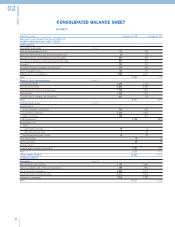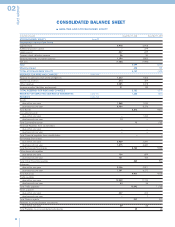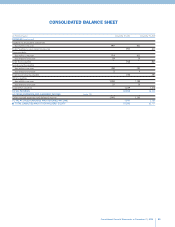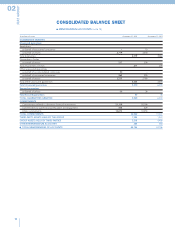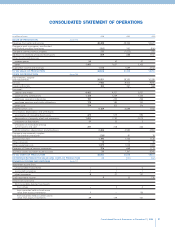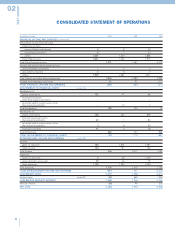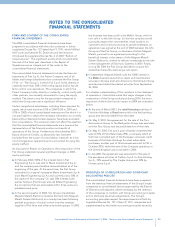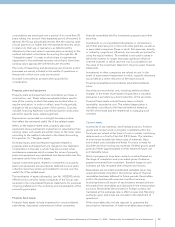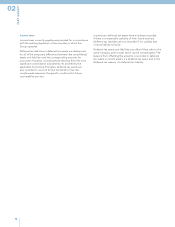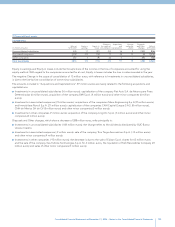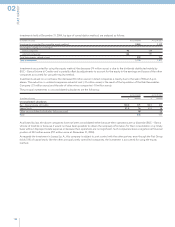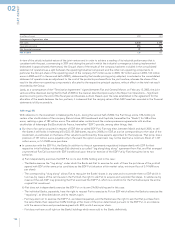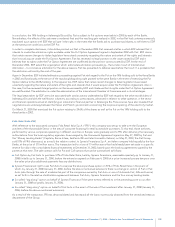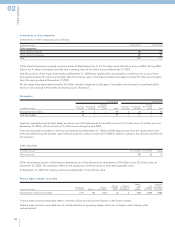Chrysler 2004 Annual Report Download - page 98
Download and view the complete annual report
Please find page 98 of the 2004 Chrysler annual report below. You can navigate through the pages in the report by either clicking on the pages listed below, or by using the keyword search tool below to find specific information within the annual report.
FIAT GROUP
02
96
refers to particular programs of discounting trade receivables
without recourse, with a collateral deposit as a guarantee).
Current assets also include investments and securities acquired
as short-term investments which are valued at the lower of cost
or market, cost being determined on a Last-In First-Out (LIFO)
basis.
Treasury stock consists of Fiat S.p.A. shares bought by Fiat; it
is valued at the lower of cost or market, cost being determined
on a Last-In First-Out (LIFO) basis or the exercise price of the
stock options serviced by the treasury stock.
A specific reserve for treasury stock is also recorded under
the stockholders’ equity of the Group for the same amount.
Reserves for risks and charges and employee
severance indemnities
The reserves for risks and charges include provisions to cover
losses or liabilities likely to be incurred but uncertain as to the
amount or as to the date on which they will arise.
In particular, the reserve for pensions and similar obligations
includes provisions for long-term service or other bonuses
(including pension funds required by some countries in which
the Group operates), payable to employees and former
employees under contractual agreements or by law, recorded
on an actuarial basis, where applicable. In particular, where
reference is made to IAS 19 “Employee Benefits” for the
accounting of certain contractual features in the absence
of specific Italian regulations, the Group has adopted the
“corridor“ method.
Restructuring reserves include the costs to carry out corporate
reorganization and restructuring plans and are provided in the
year the company formally decides to commence such plans
and the relative costs can be reasonably estimated.
The reserve for employee severance indemnities comprises
liability for severance indemnities that Italian companies
accrue each year end for employees, as determined in
accordance with labor legislation. In particular, the liability
includes a portion of the employee’s annual salary and is
indexed for inflation in accordance with Italian rules.
Payables
Payables are recorded at face value; the portion of interest
included in the nominal amount is deferred until future periods
in which it is earned. Accounts payable denominated in foreign
currency are translated at the exchange rate in effect at year
end. Resulting exchange gains and losses are included in the
statement of operations.
Taxes payable includes the tax charge for the current year
recorded in the statement of operations.
Accruals and deferrals
Accruals and deferrals are determined using the accrual
method based on the income and expense to which they
relate.
Securitization of financial receivables
The Fiat Group has programs for discounting financial
receivables originated by the financial services companies
using securitization transactions. This discounting of financial
receivables calls for the sale without recourse of a portfolio of
financial receivables to a non-Group securitization vehicle. This
company finances the purchase of the portfolio by issuing
securities which it backs (Asset Backed Securities). The
securities issued are divided into two types having different
characteristics: the first is placed on the market, occasionally
subdivided by various classes of ratings, and subscribed to
by investors; the second, the reimbursement of which is
subordinated to the first, is subscribed to by the seller. The
risk for the seller is limited to the portion of the securities
which it has subscribed. At the end of each accounting period,
therefore, such securities are evaluated in relation to the
performance of the receivables sold and may be written down
on the basis of this evaluation. These securities are recorded
in Financial receivables.
Lastly, these sales without recourse require the immediate
recognition of the present value of the future margin implicit in
the receivables sold, net of discounting costs. This net value is
included in the Value of production since it relates to revenues
arising out of the normal operations of the financial services
companies (to this end, the financial income of such
companies is included in revenues from sales and services,
as described in the relevant note).
Memorandum accounts
Derivative financial instruments
Financial instruments used to hedge exchange and interest
rate fluctuations and, in general, changes in the assets and
liabilities, are presented in Note 14. Derivative financial
instruments are recorded at inception in the memorandum
accounts at their notional contract amount.
Beginning in 2001, the Fiat Group adopted – to the extent that
it is consistent and not in contrast with general principles set
forth in the Italian law governing financial statements – the
international accounting standard IAS 39 “Financial Instruments:
Recognition and Measurement”, applicable beginning January
1, 2001. Such principle covers the accounting treatment of
all financial assets and liabilities in and off-balance sheet and,
in particular, states that derivative financial instruments
should be valued at fair value. Taking into account the
restrictions under Italian law and the evolution of the law now


